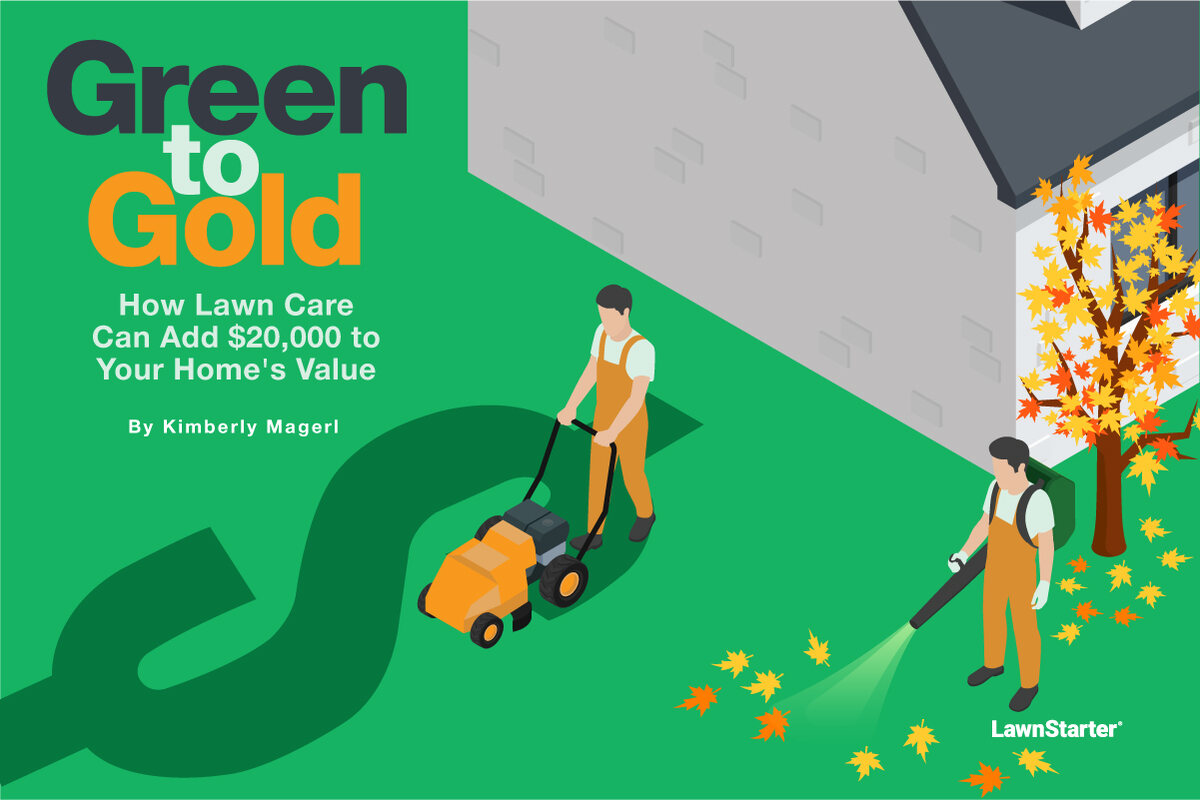
Green to Gold: How Lawn Care Can Add $20,000 to Your Home's Value
Potential buyers judge your home before they step through the front door, and it all starts with the lawn they see on real estate sites and when they pull up to the curb.
They aren’t just seeing green. Studies show that a well-maintained lawn can help put buyers at ease, signaling care and value, which can translate directly into dollars.
How much green are we talking about? $20,000 to $25,000 in many cases.
The Numbers Behind the Green
First impressions matter both online and in person, and professional landscaping can boost a home’s value by 15% to 20%.
“A well-maintained lawn signals upkeep and care, which is often associated with the overall condition of the home and how much interest it might receive,” says Amber Kuefner, a realtor at Florida Home Sales & Development.
Savvy buyers notice your lawn first, and it’s worth around 5% of your total landscaping ROI. Depending on your home’s price, your lawn could add an extra $25,000, turning your green lawn into gold.
How does regular lawn care compare to major home improvement projects when you sell your home?
Kitchen and bathroom remodels often take the spotlight regarding home improvements, but they don’t offer the best return on your investment.
• Kitchen upgrades yield an average of 38% to 91% ROI.
• Bathroom renovations return between 32% and 73%, depending on the scale of the project.
Lawn improvements are relatively low-cost and can offer a return on investment of 100% or more, meaning you can recover every dollar spent on lawn care and boost your home’s curb appeal.
Regional ROI
And what about a messy yard? How does that affect your home’s value?
Poor landscaping can reduce property values by 10% to 30%, according to the National Association of Realtors (NAR) and Trees.com. That’s tens of thousands of dollars just from neglected lawns, dying plants, or poor curb appeal.
And is your green-to-gold payoff richer in certain areas of the country compared to others?
🌿 Landscaping ROI Calculator
💡 With good landscaping:
🏡 +15% =
🏡 +20% =
⚠️ With poor landscaping:
🏚️ –10% =
🏚️ –20% =
🏚️ –30% =
Midwest
In the heartland, well-timed fertilization, aeration, and pest control can help keep lawns here healthy and home values intact. Landscaping can also increase home values in this region by up to 10% or more.
And an unruly lawn or patchy grass has its costs, too. According to NAR, real estate professionals in the Midwest were the most likely to say poor landscaping can significantly lower a home’s value.
Northeast
The Northeast’s shorter growing season makes fall lawn care essential. Raking and bagging or hiring leaf removal crews is a must, and that increases your lawn care costs – but you’ll get that back at the sale.. A yard covered in leaves looks like a lot of work for a would-be homebuyer.
Most Northeast lawns have cool-season Kentucky bluegrass, which requires regular dethatching. Seeding, fertilization, and moisture control are also important.
Southwest
Drought, water restrictions, and summer heat make traditional lawns harder to come by in the Southwest. Grass struggles to survive, and many homeowners are turning to xeriscaping, low-water, drought-tolerant landscaping, as a way to stay green (and keep property values high) without grass.
Across Arizona and in drier regions in other states, a beautifully xeriscaped, almost no maintenance yard will fetch a higher price at sale than a home with a traditional hard-to-keep-green lawn.
Southeast
The Southeast has a long growing season and plenty of rainfall. However, the region’s heat, humidity, and pests can turn a lawn patchy if it’s not maintained. Routine mowing, aeration, and pest control are a weekly chore that shifts to biweekly or monthly in winter months.
Northwest
The Pacific Northwest has natural advantages like mild temperatures, frequent rainfall, and nutrient-rich soil, all of which contribute to healthy lawns. In this region, a healthy lawn is the norm, not the exception.
With ideal growing conditions, buyers in the Northwest often expect perfection, making lawn neglect especially costly.
South
A green lawn is an expectation in the South. Neighbors notice (bless your heart), they judge, and HOAs enforce maintenance. But maintaining a lawn can be a full-time job between intense sun, sudden storms, and pest-friendly conditions.
Homeowners need a year-round lawn care strategy to stay competitive in Southern real estate markets.
Top Lawn Details That Influence Buyers
No matter the region, buyers focus on the same visual cues when looking at your lawn. The fundamentals of curb appeal remain the same. A beautiful, well-maintained lawn is inviting. Artificial grass, outdoor water features, and unkempt grass deter many buyers.
Has realtor Kuefner ever witnessed a poorly maintained lawn impacting a home’s sale price or speed?
“Numerous times!” she said. “Buyers are more likely to schedule showings and submit offers on homes that appear to be move-in-ready, inside and out, before one that might require renovation and/or maintenance.”
Some lawn details that positively influence buyers include:
◉ Defined edges and manicured borders: A clean outline around grass and flower beds makes the yard look more professional.
◉ Turf density and consistent color: Full, evenly green grass signals health, while patchiness or discoloration could be a red flag.
◉ Visible weed presence: Too many weeds signal neglect.
◉ Simple fixtures: Mulch, potted plants, or decorative borders require little maintenance.
◉ Pet-friendly landscaping: Safe plant choices can be a bonus.
How Does the Market Affect Lawns?
Lawn improvements should match your home’s price point. What works for a starter home won’t work for a luxury listing, and over-investing in the wrong upgrades is costly.
“The best lawn care ROI is seen on low- to mid-range homes, as clean landscaping and curb appeal stand out and often help the home sell faster,” real estate agent Kuefner says. “High-end luxury homes are expected to have a well-manicured home, so the ROI may be lower.”
One of the most important things buyers should remember when listing their home is that the exterior shot usually leads the listing photos. Communicating value immediately can translate into a quicker sale, adds Heather Wright, design trends expert writer for NewHomeSource.com.
Expectations for lawn care range from low maintenance to picture-perfect and vary from luxury homes to starter houses. Selling your home at a higher price often is proof that you helped your home match the look while also standing out in your neighborhood.
Luxury Market Expectations
When selling a luxury home, the lawn isn’t just grass. Upscale buyers expect the exterior to reflect the home’s quality, which means perfection is the baseline. They expect a flawless lawn and landscaping, trimmed hedges, fresh mulch, shaped trees, and seasonal color arranged with intention.
Mid-Range Listings
Mid-range homes are in between; buyers want visual appeal with little maintenance. The goal is to create a clean, well-maintained lawn that feels move-in ready.
Focus on healthy grass with no major bare spots. Add curb appeal with defined edges, fresh mulch, and low-maintenance plants. A pop of color, like potted flowers or small shrubs at the home’s entryway, can go a long way without breaking the bank.
Starter Homes
With starter homes, it’s all about keeping it neat and functional. First-time buyers may not expect perfection, but they’ll notice if the lawn looks neglected.
Make sure the grass is trimmed and weeds are under control. Minor improvements like reseeding bare spots, adding mulch, or edging the lawn can improve curb appeal at a minimal cost.
A beautiful lawn does more than boost curb appeal. It can add serious value to your home. Experts say a well-maintained lawn can increase your home’s price by 5% or more, and landscaping improvements often offer 100% or more ROI.
On a $300,000 home, that’s potentially $21,000 or more for upgrades that cost far less.
That’s how you turn green to gold.
“To boost curb appeal, I would recommend the basics such as mowing, edging, weeding, and seeding as they all go a long way when trying to sell,” Kuefner says.
“Upgrades such as adding mulch beds, rock or gravel features, and low-maintenance plants do numbers as well,” she adds. “The key is to keep it simple and low maintenance.”
Whether you’re selling a starter home or a luxury estate, the smartest lawn investments are the ones that match your market, highlight your home’s best features, and make potential buyers feel confident from the curb.
Main Illustration Credit: Aris Berroya / LawnStarter
ABOUT THE AUTHOR

Kimberly Magerl has been writing and editing articles and studies for LawnStarter for the past 3 years. She lives in Austin, Texas, LawnStarter’s home base, and is a proud plant mom.
ABOUT THE PROJECT EDITOR

LawnStarter editor-in-chief Jeff Herman has lived in Texas for more than 10 years, first in Austin and now in Dallas. He has been researching, writing and editing lawn care articles for LawnStarter for nearly 5 years.